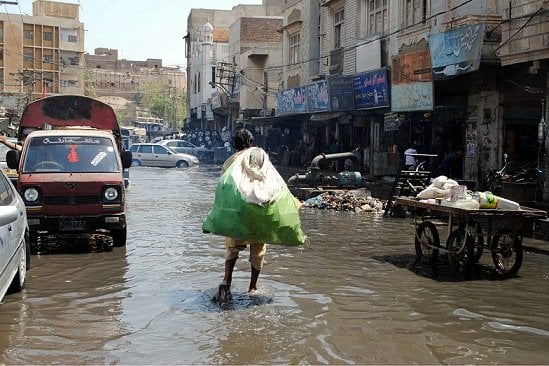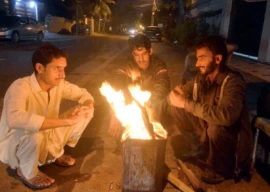
The city, inhabited by three-and-a-half to four million people, according to an estimate, remains beset with dismal health hazards as there continues to be supply of unsafe drinking water, contamination of the waterways and burning of solid waste in residential areas.
These are in addition to a multitude of other problems, which are hallmarks of a haphazard and unbridled process of urbanisation.
This week, the Pakistan Peoples Party's Sindh government presented the 10th budget of its second consecutive tenure, allocating Rs7.65 billion for Hyderabad's urban infrastructure projects, which also include roads and bridges.
Rs7.65b earmarked for second-largest city of Sindh
However, even these billions of rupees offer no remedy in the short-term. "The water demand during peak summer balloons to a 100 million gallons per day (MGD). We have no choice but to compromise on the filtration quality in order to meet the demand," conceded Masood Jumani, director-general of the Hyderabad Development Authority, who also holds the charge of managing director of Water and Sanitation Agency (Wasa), while talking to The Express Tribune.
The installed capacity of Wasa's six filtration plants is 60 MGD, but this capacity stands reduced due to a lack of repair and maintenance by Wasa, which perpetually claims to be in dire financial straits.
Apart from the new filtration plant of 30 MGD on Jamshoro Road, which recently restarted chlorination on the judicial commission on water and sanitation's order, other plants are supplying almost raw water. The Wasa officials do not mince words admitting that water is not potable when it reaches the consumers due to defects in the filtration and distribution network.
Development Package: Rs500m announced for Hyderabad
"All government departments get funds for repair and maintenance, unlike Wasa. We are even unable to regularly pay salaries to employees from our own revenue [collected through utility bills]," claimed Jumani. The agency has a consumer base of around 150,000 people, but only between 35% and 40% of them, excluding the government consumers, pay their bills.
Wasa submitted a proposal for the allocation of Rs200 million for the repair and maintenance of the distribution network as a broken and rusted supply line adds impurities in the water. That proposal, however, was not approved in the budget.
The provincial government has, however, added four projects worth Rs724.4 million in its 2017-18 budget for the rehabilitation of many plants of Wasa, including the 30MGD plant.
Rs1.04tr populist Sindh budget unveiled
Meanwhile, in the next fiscal year, only one-fourth of the total cost of rehabilitation, Rs181 million, will be released. By this account, it will take at least four years for the release of the total funds and the same time for the restoration of all the components of the filtration process of these plants.
"Since 1991, there has been no new addition in the filtration plants. Sadly, the successive governments did not pay attention to the rising population and ever increasing demand for water," Jumani observed, while taking credit that under his headship, two new plants of 100 MGD and 6MGD respectively are being planned. These new plants will increase the total capacity to 165 MGD.
Although Wasa has yet to prepare and submit the PC-1 of the project to the provincial government, a sum of Rs1.38 billion has been set aside for the fiscal year of 2017-18 for the 100 MGD plant, which will cost Rs5.5 billion.
Budget 2015-16: Sindh presents Rs739b budget
According to Jumani, the plant will be located near Miani Forest along the National Highway. It will primarily meet the demand of the northern parts of Hyderabad, mainly Qasimabad taluka, which is witnessing an exponential surge of inhabitants who are predominantly migrating from rural Sindh to Hyderabad.
"This plant will take at least four years to complete, according to the plan, but, looking at the Sindh government's previous record of the release of allocated funds, one can safely assume a delay of two to three years," an official of WASA, who requested anonymity, said. "By that time, who knows, the city's peak demand may double to 200 MGD."
The Muttahida Qaumi Movement - Pakistan's Hyderabad district's organiser, MPA Rashid Khilji, said that in their budgetary proposals, they requested the government to enhance the capacity of the existing plants while adding new ones in the system. However, he lamented, their suggestions were not taken up.
Sewage treatment
Hyderabad's municipal and industrial sewage is discharged directly in the Indus River and Phuleli Canal. Although, three sewage treatment plants were built for City, Latifabad and Qasimabad talukas, none became operational because of the incomplete components of the projects.
PSP rejects Sindh budget
The budget for 2017-18 has added the rehabilitation of northern and southern treatment plants at Hala Naka and Qasimabad respectively but activation of these plants too will take four or more years. Like the filtration plants, the treatment plants will also receive only one-fourth of the total rehabilitation cost of Rs550 million in the next fiscal year.





1732697578-0/Untitled-design-(5)1732697578-0-270x192.webp)











COMMENTS
Comments are moderated and generally will be posted if they are on-topic and not abusive.
For more information, please see our Comments FAQ